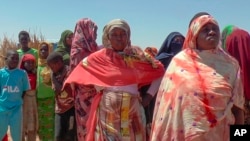The United Nations refugee agency says thousands of people are still fleeing Sudan every day as clashes between two warring army factions, raging for nearly a year, show no signs of abating.
The latest UNHCR figures show that more than 8.5 million people in Sudan have been forced to flee their homes since war erupted on April 15, 2023, making this one of the largest displacement and humanitarian crises in the world.
The number includes 1.8 million Sudanese who have fled to neighboring countries seeking refuge.
The UNHCR says fighting between the Sudanese Armed Forces and paramilitary Rapid Support Forces has shattered peoples’ lives. It says attacks on civilians are escalating, human rights violations are widespread and rampant, conflict-related sexual and gender-based violence continues without stop, and the economy has collapsed.
“While the war started one year ago, thousands are crossing borders daily as if the emergency had started yesterday,” UNHCR spokesperson Olga Sarrado told journalists in Geneva Tuesday.
“Chad has experienced the largest refugee arrivals in its history. While teams from UNHCR and partners continue to work and relocate refugees to expanded and new settlements, over 150,000 remain in border areas in overcrowded and unsanitary conditions, mainly and largely due to funding shortfalls,” she said.
The UNHCR says more than 1,800 people are arriving daily in South Sudan alone, increasing pressure on the country’s overstretched infrastructure and worsening vast humanitarian needs.
“Some 635,000 people have arrived in South Sudan since the 15th of April last year, which represents more than 5% of the population of South Sudan,” said Marie-Helene Verney, UNHCR representative in South Sudan, speaking from the capital, Juba.
To put that number in perspective, she said 635,000 people would be equivalent to 4.5 million people arriving in less than one year in Germany or about 17.6 million people arriving in less than one year in the United States.
“This is the world’s poorest country, so you can imagine the pressure that is being put on this country,” she said. “There are very few roads, pretty much all humanitarian assistance has to be airlifted, at significant cost. We are approaching the rainy season again, so we are facing the risk of disease, particularly cholera.
“Unfortunately, we all know that the risk of sexual violence is high during transit,” she said, “and we have heard of heartbreaking stories of what has happened to women who have had to flee when they were in Sudan.”
Verney said the profile of many of the refugees presents challenge and opportunity as “many tend to be very urban.”
She said those who arrive from Sudan mostly lived in the capital, Khartoum, and the city of Wad Madani and “are very middle class, very educated, and have professional skills, mainly in health and education.”
The urban people are “reluctant to live in refugee camps,” she said, so UNHCR is working with South Sudan to match their skills with the gaps that exist in the country.
The UNHCR’s Sarrado notes other countries of asylum, including the Central African Republic, Egypt and Ethiopia, also are experiencing large daily inflows of Sudanese refugees and the many logistical challenges that come with them.
“Those crossing borders, mostly women and children, are arriving in remote areas with little to nothing and in desperate need of food, water, shelter and medical care. Many families have been separated and arrive in distress. People and children have witnessed or experienced appalling violence, making psychosocial support a priority. Many children arrive malnourished,” she said.
As the conflict continues and the lack of assistance and opportunities deepens, Sarrado warned that “more people will be forced to flee Sudan to neighboring countries or to move further, risking their lives by embarking on long, dangerous journeys,” seeking safety in countries further afield.
In the last year, the UNHCR reports Uganda has welcomed 30,000 Sudanese refugees, including over 14,000 since the start of the year.
Additionally, UNHCR statistics show more Sudanese refugees are going to Europe, with 6,000 arriving in Italy from Tunisia and Libya since the beginning of 2023 — an almost six-fold increase from the previous year.
Despite the magnitude of the crisis, Sarrado said funding remains critically low, saying that “only 7%” of the UNHCR’s $1.4 billion 2024 Regional Refugee Response Plan for Sudan has been received.
She said UNHCR and partners are saving lives in many locations, but firm commitments from international donors to support Sudan and the countries hosting refugees “are needed to ensure those forced to flee by the war can live in dignity.”











